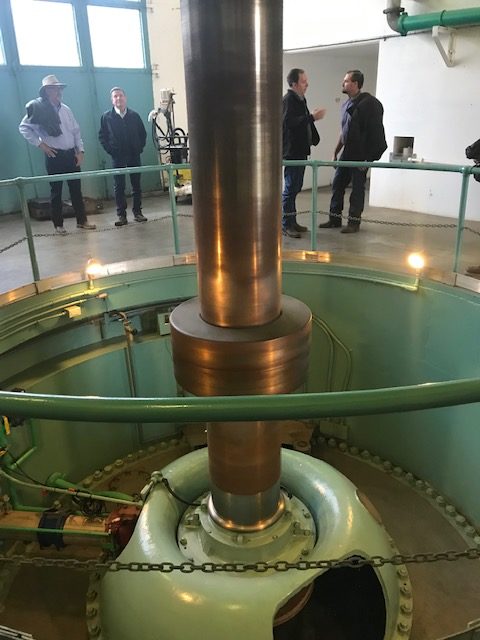 The Westlands Water District held its board of directors meeting on Tuesday, May 17, 2022 at its Fresno headquarters. Westlands is fixing to move to a new headquarters building someday. Hopefully the boardroom will have more space. The current facilities have a limited amount of room for guests. Don’t get me wrong, the WWD offices are a warm and friendly place to loll away an afternoon typing. It’s just more fun when one can do so without one’s knees under one’s chin. Also the big screen tv is mounted above and behind the seated guests. Which is good for the board but anyone else needs the neck joints of a hoot owl to see any slides or other visuals.
The Westlands Water District held its board of directors meeting on Tuesday, May 17, 2022 at its Fresno headquarters. Westlands is fixing to move to a new headquarters building someday. Hopefully the boardroom will have more space. The current facilities have a limited amount of room for guests. Don’t get me wrong, the WWD offices are a warm and friendly place to loll away an afternoon typing. It’s just more fun when one can do so without one’s knees under one’s chin. Also the big screen tv is mounted above and behind the seated guests. Which is good for the board but anyone else needs the neck joints of a hoot owl to see any slides or other visuals.
Chairman Ryan Ferguson called things to order at 1:00pm on the nose. Before the actual meeting there was an equalization hearing for the Westlands 2022 benefit assessment rates. If I heard correctly the minimum is $2 per acre and it goes up from there depending on the type of services received. Bobbie Ormonde gave the facts and she did such a good job there was absolutely no comments from anyone and the board passed the given recommendations unanimously.
The Board Meeting
The minutes were approved as was the agenda. For some reason things jumped to item 12, a review of allowing the public access online. Ormonde said there are problems with sound and completeness of information. Director Kevin Assemi asked if there is a record of how many folks tuned in on Zoom compared to attended before. That is not known according to the authorities. There was more discussion and no one on the board, no one from the public wanted Zoom to go away. There was an overwhelming amount of support to continue Zoom. It’s a bit more of a hassle for staff but face it, Westlands has competent staff, some of the best. The vote was in favor of retaining Zoom with everyone but Ferguson in favor. I don’t know why it didn’t spark him but it didn’t. It still passed.
public wanted Zoom to go away. There was an overwhelming amount of support to continue Zoom. It’s a bit more of a hassle for staff but face it, Westlands has competent staff, some of the best. The vote was in favor of retaining Zoom with everyone but Ferguson in favor. I don’t know why it didn’t spark him but it didn’t. It still passed.
The Star Program
Next Chuck Gardner and Curtis Creel of the Hallmark Group gave a presentation on some options to meet the district’s water needs through localized banking known as the STAR Program and I forgot what that stands for. Gardner spoke last month and this month he’s providing more detail. Recharge is the way being touted and maybe someday the state will recognize it officially as a beneficial use, I’ll bet you that happens. In the meantime Gardner and Creel are looking at putting 125 recharge wells. I’m not sure the difference between that and injection wells but there must be one. The recharge wells are estimated at $1million per. So, that’s not a small number at all. These wells will help recharge the aquifer with 215 Water, that’s extra water from the Central Valley Project during flood time or other non CVP water from other sources such as sales.
Director Frank Coelho asked why not spend that money on On Farm Recharge? Assemi asked why not save money with recharge ponds. Coelho said adapt and hook up existing grower wells. Director William Bourdeau asked if they compared recharge wells verses ponds. Gardner said they are looking into it. He asked the board to keep in mind the scale and the raising interest rates have to be considered in any decision in order to keep costs down. There are already a number of such wells in Westlands if I understood, but they were paid for by grants. COO Jose Gutierez said there is a reluctance by growers to monkey around with operational wells. Gardner said there has been an analysis and he’s looking at 63,000 a/f extra per year. Director Ceil Howe III asked if the district has enough canal capacity to deliver a large slug of water during the wet year. Gardner said that has been taken into account and the storage areas that can best serve the needs. Director Jim Anderson said offer the excess water to landowners and the district can be the backstop for the rest. Assemi said he would like to see this water available to everyone to avoid a have and have not situation within the district. Gutierez proposed a scenario of more turnouts to facilitate this. He also had a schedule to avoid water quality problems and take advantage of any spills out of San Luis Reservoir.
Creel spoke and said ideally storing water on the surface is the easiest to access and this project includes a 50,000 a/f basin. He said having this will open options for how San Luis is operated. It is possible this will allow for less recharge wells because you can spread out the time needed with this extra storage. General Manager Tom Birmingham said this will not be a substitute for storage in San Luis, he didn’t want the board to be confused. At some point the Chairman asked the directors to please hold their questions for after the presentation since it was slowing things way down. Birmingham told Gardner he’d gone over his allotted 20-minutes and that had to be 45-minutes into it. That got one of the best laughs I’ve heard him get at a meeting. Good for him.
Recall the big screen is in the way back so when Gardner started discussing costs and referring to the different variables and constants I would have had to turn my face to the wall and stand on a chair to maybe get a glimpse. So, you’ll have to get details elsewhere. But if you have 10,000 acres it’s going to cost you $190,000 and something in land based charges. Gardner explained to the board the Excel program wouldn’t let them calculate to less than four spaces so the math on the slide wasn’t the same as simple math. He wanted them to know they can multiply 190 x 10,000. There are also treatment plants involved in all this and of course there is capital costs, O&M costs and whatever else. I think the ultimate cost per acre foot is maybe $383 per a/f, for sure he said something under $400 per a/f but he went through a lot of math to get there.
Assemi asked how much this is going to cost and Gardner said $41 million (I think) to get 100 percent design and permitting. Director Jeff Fortune asked if the basins, being little lakes, will end up responsible to some government agency. Creel said if the outside of the bank is above six feet the state’s Department of Dam gets its nose and nuts in the middle of it. Assemi and Anderson suggested cutting back the number of wells from 125 and build the 50,000 a/f basin. Instead of the number of wells, more recharge basins. That took about an hour and a half.
GM Report
Birmingham asked Deputy GM of Resources Russ Freeman to report on 171,000 a/f of surface water supplies this year. So far groundwater pumping has been more than 100,000 a/f so far. There may be as much as 600,000 a/f pumped because the Yuba Transfers are not going through. We covered that at the San Luis Delta Mendota Water Authority meeting. Storage Component Water, another name for the supplies in the Yuba Accord was not available because it rained more than expected. Birmingham added the SCW is released to provide flow in the lower Yuba River for fish. When natural inflow into the Delta is enough to provide the fish need this SCW isn’t being released. It’s a matter of color behind the dam. Freeman said the cost will go up using groundwater transfers from Sacramento Valley and that is going to be $1,500 per a/f after you add carriage loss and other factors. There is some water available from the Mendota Pool if I understood. That would mean pumping from the Pool into canals if I’m correct.
Tom Boardman reported Shasta is at 1.8 million a/f, about half for this time of year. That will put the US Bureau of Reclamation on the knife’s edge for balancing releases. However, Folsom Reservoir is full and that can add some pumping this summer. Currently the federal Jones plant is pumping one unit. Not much for the busiest time of the year. The Cooperative Operating Agreement balance has the state owning the feds 200,000 a/f and Oroville has a good supply also. So that helps by reducing Shasta releases and more exports that benefit the Exchange Contractors.
Member of the audience and Water Savant Mitch Partovi asked if there is any supplemental water available north of the Delta. Birmingham said staff is looking to bring as much water in as it can.
Freeman said the SLDMWA met in person and approved a contract with the Hallmark Group for project management for the BF Sisk Dam raising on the San Luis Reservoir.
Ferguson said the highlight for the district was a check for $6.4 million at ACWA.
Attorney Jon Rubin had nothing for open session. Engineer Kiti Campbell told the board about a WaterSmart Grant opportunity and the board approved Resolution 116-22 so the district will apply for the 50 percent cost share. It’s CEQA exempt and raring to go.
SGMA
Campbell said there will be a special board meeting on Monday May 23rd to discuss the rules and regs for the GSA to implement the GSP. She also said staff has been able to remove 3,000 acres from being listed as subsiding. This will be finalized at the May 23rd meeting if I understood. There is a big Aquifer Recharge Storage federal grant out there. Birmingham said there are consultants in Washington DC looking for as much grant money as they can find. He said Westlands has brought in $15 million in grant funds in the past year. Shelly Cartwright, Assistant GM Water Policy said there was a big loan opportunity that didn’t get consideration as it was debt. Coelho said if needed hire experts to bird dog the grants and if they find any for growers Westlands needs to blow its trumpet. Amen brother.
rules and regs for the GSA to implement the GSP. She also said staff has been able to remove 3,000 acres from being listed as subsiding. This will be finalized at the May 23rd meeting if I understood. There is a big Aquifer Recharge Storage federal grant out there. Birmingham said there are consultants in Washington DC looking for as much grant money as they can find. He said Westlands has brought in $15 million in grant funds in the past year. Shelly Cartwright, Assistant GM Water Policy said there was a big loan opportunity that didn’t get consideration as it was debt. Coelho said if needed hire experts to bird dog the grants and if they find any for growers Westlands needs to blow its trumpet. Amen brother.
Finances
Ormonde gave the board some financial information and reports and they were very comfortable with her guidance in this area and voted yes on everything from budget transfers to paying the bills. There was a long discussion about either establishing or augmenting a reserve fund and how to pay for it. Assemi said if you’re going to penalize a grower for over pumping, make it a penalty for over-pumping. Rubin said today’s discussion doesn’t have to end up in vote. The board decided to send this one back to the Finance & Administrative Committee. Grower Justin Diener spoke saying the booster pump program back in 2019 raised the costs per pumping over that of PG&E. He wasn’t in favor of this.
discussion doesn’t have to end up in vote. The board decided to send this one back to the Finance & Administrative Committee. Grower Justin Diener spoke saying the booster pump program back in 2019 raised the costs per pumping over that of PG&E. He wasn’t in favor of this.
Under public comment Sarah Woolf asked the board to consider including a report on SFWCA. Diener suggested a land retirement to be considered.
Closed Session
The only thing left after all of this was the board going into closed session. While I stumbled from the room weary, ready for a power nap at about 3:25pm the nine men of the Westlands Board strode confidently into closed session, heads held high. Proud to have stayed awake during the open session after a morning of committee meetings. Yet they knew the real test of serial meeting stamina was only beginning. They still had more than 20 closed session items to deal with. God speed. And may the rest of us go be good to each other.
DISCLAIMER OF RESPONSIBILITY; Waterwrights strives to provide clients with the most complete, up-to-date, and accurate information available. Nevertheless, Waterwrights does not serve as a guarantor of the accuracy or completeness of the information provided, and specifically disclaims any and all responsibility for information that is not accurate, up-to-date, or complete. Waterwrights’ clients therefore rely on the accuracy, completeness and timeliness of information from Waterwrights entirely at their own risk. The opinions expressed in this report are those of the author and do not represent any advertisers or third parties.
ALL RIGHTS RESERVED. Copyright 2022 by WaterWrights.net/DAW
Westlands Water District
3130 N. Fresno Street, Fresno CA 93703 Phone:559/224-1523
Board: Ryan Ferguson -President, Frank Coelho Jr. – Vice President, Jim Anderson, William Bourdeau, Kevin Assemi, Ceil Howe III, Daniel Errotabere, Stan Nunn & Jeff Fortune.
Staff: Tom Birmingham-General Manager, Jon Rubin-Attorney, Jose Gutierrez-COO, Russ Freeman-Deputy GM Resources, Elizabeth Jonasson-Public Information Officer, Shelly Cartwright-Associate GM Water Policy/ Public Affairs Representative, Kitty Campbell-Supervisor of Resources, Bobbie Ormonde-VP of Finance & Administrative Affairs
About: Without irrigation, farming in the Westlands area of California would be limited and ineffectual. The history of Westlands is one of continual adaptation, careful water stewardship and advanced technology. By maintaining a fierce commitment to sustainability, the Westlands’ comprehensive water supply system continues to adapt, educate, and surpass conservation goals. Throughout its history, Westlands Water District has demonstrated a lasting dedication to water conservation and recognized that the long-term survival of its farms depends on the effective management of California’s precious water resources. From www.wwd.ca.gov


































